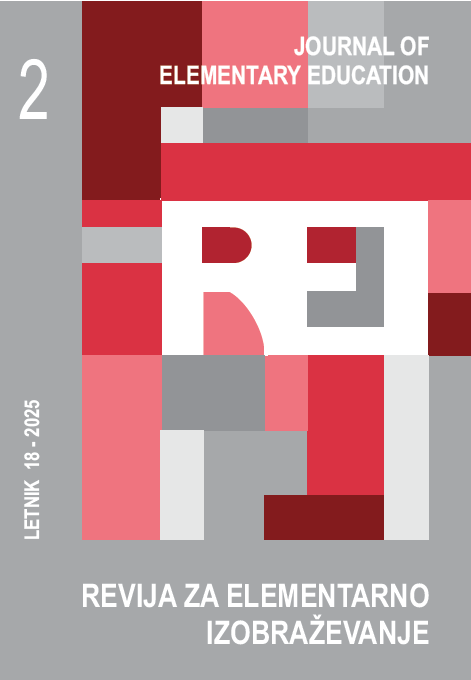The Importance of Developing Multiple Intelligences Among Pupils at Inclusive Primary Schools
DOI:
https://doi.org/10.18690/rei.3837Keywords:
inclusion, multiple intelligences, differentiated learning, formative assessment, universal learning design.Abstract
In this article, we explore the awareness of educational professionals regarding the use of Gardner’s theory of multiple intelligences (MI) in inclusive schools. The research involved 49 educational professionals from selected primary schools. We found that they were generally familiar with Gardner’s MI theory, but most do not use it intentionally in their teaching. They most often develop interpersonal, verbal-linguistic, and mathematical-logical intelligence, while bodily-kinesthetic, spiritual, and musical-rhythmic intelligences remain less frequently stimulated. In an inclusive school, it is crucial for teachers to use Universal Design for Learning, which addresses different types of intelligence and enables more differentiated teaching.
References
Altan, M. Z. (2020). Extrability and the theory of multiple intelligences as a phenomenon for an inclusive education renewal. European Journal of Special Education Research, [S. l.], jan. 2020.
Bolanos, P. (2002): Multiple Intelligences, Projects and Assessment. Intervju za revijo Edutopia. Pridobljeno 30. 6. 2022 s https://www.edutopia.org/ .
Cerovšek, A. (2022). Razvijanje mnogovrstnih inteligentnosti učencev na izbrani osnovni šoli. Magistrsko delo. Koper: Univerza na Primorskem, Pedagoška fakulteta.
Delors, J. (1998). Learning: The treasure within. Unesco.
Friend, M. (2014). Co-Teach!: building and sustaining effective classroom partnerships in inclusive schools. Marilyn Friend, Incorporated.
Fuchs, D., in Fuchs, L. S. (2006). Introduction to response to intervention: What, why, and how valid is it?. Reading research quarterly, 41(1), 93–99.
Gardner, H. (1995). Razsežnosti uma: teorija o več inteligencah. Ljubljana: Tangram.
Gardner, H. (2006). Multiple intelligences: New horizons. New York: Basic Books.
Ginsberg, M. B. (2005). ‘Cultural diversity, motivation, and differentiation’. Theory into Practice, 44(3), 218–225.
Goleman, D. (1995). Emotional intelligence. New York: Bantam Books
Holcar Brunauer, A., idr. (2017). Formativno spremljanje v podporo učenju. ZRSŠ.
Katz, J. (2013). The Three Block Model of Universal Design for Learning (UDL): Engaging students in inclusive education. Canadian Journal of Education, 36(1), 153–194.
Kiswarday, V. R. (2014). Model spodbujanja rezilientnosti v šolskem okolju. Revija za elementarno izobraževanje, 12(3). str. 267–290.
Kiswarday, V. R. (2018). Individualiziran program v inkluziji. V Schmidt Krajnc, M., Rus Kolar, D., & Kranjec, E. (Eds.). Vloga inkluzivnega pedagoga v vzgoji in izobraževanju – konferenčni zbornik, 2018, 47–58.
Kiswarday, V. R. (2020). Individualizacija vzgoje in izobraževanja v inkluziji - študijsko gradivo. Koper: Univerza na Primorskem, Pedagoška fakulteta.
Kiswarday, V.R., Rejc, M., in Pak, M. (2020). Sodelovalno poučevanje v inkluzivnih razredih - Priročnik za sodelovalne pare. Koper: e-priročnik, Koper: Univerza na Primorskem, Pedagoška fakulteta.
Komljanc, N. (2008). Razvoj didaktike ocenjevanja. V Didaktika ocenjevanja. ZRSŠ.
Krek, J., in Metljak, M. (2011). Bela knjiga o vzgoji in izobraževanju v Republiki Sloveniji 2011. Ljubljana: ZRSŠ.
Kukanja Gabrijelčič, M., in Gorela, K. (2018). Nadarjenost na predšolski stopnji. Koper: Založba UP.
McGuire, J. M., Scott, S. S., in Shaw, S. F. (2006). Universal Design and Its Applications in Educational Environments. Remedial and Special Education, 27(3), 166–175.
Metzner, R. (1998). The unfolding self. Novato, CA: Origin Press
Peterson, K., DeCato, L., in Kolb, D. A. (2015). Moving and learning: Expanding style and increasing flexibility. Journal of Experiential Education, 38(3), 228–244.
Plešec Gasparič, R. in Valenčič Zuljan, M. (2019). Učne oblike v osnovni šoli in obrnjeno učenje in poučevanje. Revija za elementarno izobraževanje, 12(3). str. 267–290.
Renzulli, J. S. (2016). The Three-Ring Conception of Giftednes: A Developmental Model for Promoting Creative Productivity. V S. M. Reis (ur.) (2005), Reflections On Gifted. Education (str. 55–86). Waco (Texas): Prufrock Press.
Rose, C. in Goll, L., (1993). Umetnost učenja, Ljubljana: Tangram.
Rose, D. H., in Meyer, A. (2002). Teaching every student in the digital age: Universal design for learning. Association for Supervision and Curriculum Development, 1703 N. Beauregard St., Alexandria, VA 22311–1714
Shearer, C. B., in Karanian, J. M. (2017). The neuroscience of intelligence: Empirical support for the theory of multiple intelligences? Trends in Neuroscience and Education, 2017(6), 211–223.
Stuntzner, S., in Hartley, M. (2015). Balancing self-compassion with self-advocacy: A new approach for persons with disabilities learning to self-advocate. Annals of Psychotherapy & Integrative Health, 12–28.
Story, M. F., Mueller, J. L., in Mace, R. L. (1998). The Universal Design File: Designing for People of All Ages and Abilities. Raleigh, NC: NC State University, the Center for Universal Design.
Thousand, J. R. (2007). Differentiating Instruction: Collaborative Planning and Teaching for Universally Designed Learning. En J. R. Thousand. Corwing Press.
Tolimson, C. A. (2003). Fulfilling the promise of the differentiated classroom strategies and tools for responsive teaching. Alexandria, Virginia, United States: ASCD.
Wiliam, D. (2006). Formative assessment: Getting the focus right. Educational assessment, 11(3–4), 283–289.
Downloads
Published
Issue
Section
License
Copyright (c) 2025 Vanja Kiswarday, Andreja Cerovšek

This work is licensed under a Creative Commons Attribution 4.0 International License.
